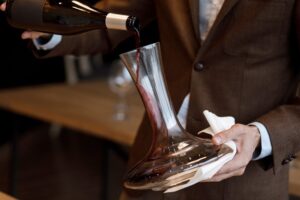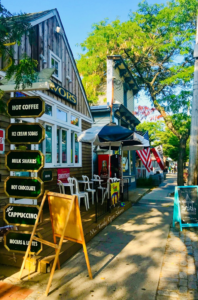There is only one reason we know that you MUST decant a bottle of wine. If the cork breaks as you open a bottle and you can’t get it out, the only option is to push it in. This makes decanting necessary.
After that, there are several reasons why you might WANT to decant your wine:
- A decanter of wine on the table is attractive and adds to the pleasure of a meal.
- The wine is too young and needs extensive aeration.
- The wine is quite old and needs a little aeration.
- The wine is quite old and probably has a lot of sediment that you don’t want to swallow.
Photo courtesy of The Manual.
Some restaurants decant wine, perhaps in an effort to justify overcharging. Some people decant wine because they think they look cool, even if it makes them look cork-dorky. And then there are the occasions when Aunt Gertrude is coming over for dinner and she gave you the decanter.
Wineries generally don’t decant their wines, although they should. They mostly serve younger releases that might benefit from some extra air.
If you are going to decant a bottle, here are some tips.
- Don’t decant too early or too late. A younger wine, and even one well within its drinking age, can be decanted hours earlier than you plan to serve it. This is not a requirement but it does get the maximum benefit of airing out the wine. But in our opinion, if you’re serving a very old wine, decant it just before serving, to let out some of the accumulated gasses in the bottle without losing flavors.
- Simple decanters work just as well as fancy ones. The objective is to expose the wine to air and to leave the sediment in the bottle. The ones that are examples of the glass-blowers’ art may be very pretty but not so easy to pour from. A simple carafe can do the job.
- Don’t decant too fast, but don’t make a big production of it, either. As the wine passes from bottle to decanter, it all meets air. If you pour too quickly, you’ll lose some of this benefit and are more likely to get some sediment into the decanter. Restaurant sommeliers and dedicated snobs will pour the wine very, very slowly, in front of a candle. That way they can see the first little bits of sediment and stop pouring. All very dramatic, to be sure, but the same thing can be accomplished in front of a well-lit white or light colored wall or even a piece of paper. Yes, pour slowly, but be reasonable about it.
- Consider double decanting. If you’re serving a bottle you’ve saved for a special occasion, you might actually want to see that well-anticipated bottle on the table. So if you think the wine would benefit from decanting, do so. Then pour the sediment out of the bottle, lightly rinse with a bit of wine and pour the wine back into the bottle. You’ll maximize the aeration as you pour twice and you still get to see that pretty label.




